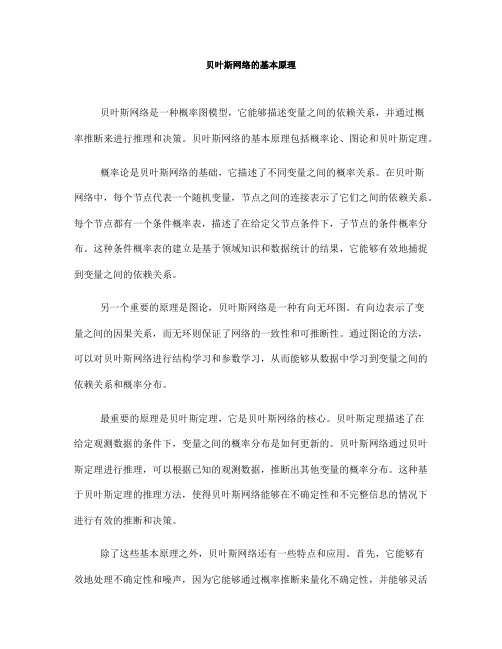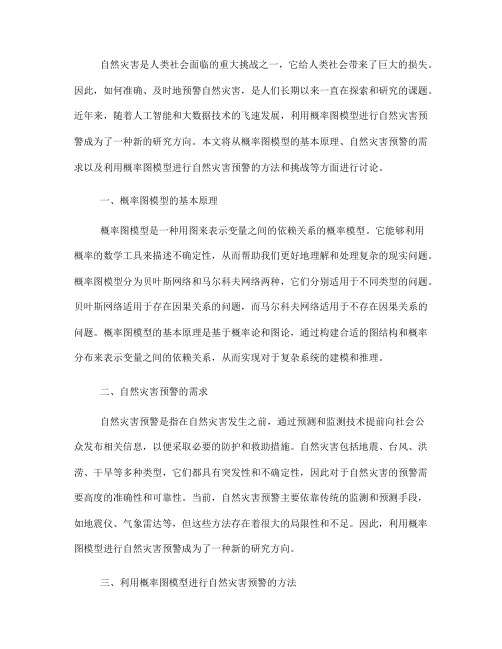概率图模型导论——概率论与图论相结合
深度学习(一):概率图模型引入

深度学习(⼀):概率图模型引⼊⼀、简介概率图模型(Probabilistic Graphical Model ,PGM )是⽤图来表⽰变量概率依赖关系的理论,结合概率论与图论的知识,利⽤图来表⽰与模型有关的变量的联合概率分布。
图的每个节点(node )都表⽰⼀个随机变量,⽽图的边(edge )则被⽤于编码这些随机变量之间的关系,通常是条件概率。
对于⼀个K 维随机变量X =X 1,X 2,...,X K ,T ,它的联合概率分布是⾼维空间的分布,⼀般很难直接建模,特别是在我们不知道它们之间的依赖关系的时候。
如果我们有三个⼆值随机变量,分别是X 1, X 2,X 3,我们可以建⽴⼀个⼆维概率表来记录每⼀种取值的概率,因为有3个变量,每个变量有2种可能的取值,即我们有23=8种情况下的联合概率值,不过当我们知道前7个概率后,第8个概率直接⽤1-就可以计算出来,所以对于三个⼆值随机变量的联合概率分布,我们需要知道7个参数来表达它的联合概率分布。
随着随机变量的个数增加,所需参数数量会指数型增加,上⼀个例⼦是2的3次⽅,如果是10个随机变量就需要2的10次⽅-1个参数来说明这个联合随机概率分布。
有⼀种想法就是,如果我们能够知道其中⼏个随机变量之间的依赖关系,可以⼤⼤减少所需参数个数,⼤致可以这么想:如果我们知道当X 1=1时,X 2只能取0,那么我们所需要的参数数量将会直接少⼀半。
所以依赖于这种想法,有⼈提出了独⽴性假设,可以有效减少参数量,把K 维随机变量的联合概率分布分解为K 个条件概率的乘积:p (x )=P (X =x )=p x 1p x 2∣x 1p x K ∣x 1,...,x K −1=∏K k =1p x k ∣x 1,...,x k −1 当概率模型中的变量数量⽐较多的时候,其条件依赖关系也很复杂,有的随机变量可能会依赖1个或多个变量,可能有两个随机变量都依赖于同⼀个随机变量,为了表⽰这种复杂的关系,就引⼊了图结构,可以直观的描述随机变量之间的条件独⽴性性质,把⼀个复杂的联合概率模型分解成⼀些简单的条件概率模型的组合,对于⼀个⾮联通图,都存在多个条件独⽴性假设,可以根据条件独⽴性来将联合概率分解。
概率图模型及其推理技术的研究现状

概 率 图模 型 ( P ob r a b i l i s t i c G r a p h i c l a Mo d e l s ) ¨
夫 随机 场 ( Ma r k o v R a n d o m F i e l d s ,MR F S ) , 更 适 合 于表 述 随 机 变 量 之 间 的 软 约 束 ( s o f t c o n s t r a i n t s ) 。 概率 图模 型具 有 Байду номын сангаас下 优 点 ] : ( 1 ) 用 简 单 的 方式 来 可视 化 ( v i s u a l i z e ) 概 率 模 型 的结 构 , 可 用 于设 计 和
u n c e r t a i n y t a n d c o mp l e x i y. T t h i s p a p e r d i s c u s s e s o n t hr e e k i n d s o f p r o b a b i l i s t i c g ra p h i c a l mo d e l ,
关键词 :概率图模型 ;贝叶斯 ;马尔可夫;因子图;推理 ;应用
S u r v e y o n p r o b a b i l i t y g r a p h mo d e l a n d i t s r e a s o n i n g t e c h n o l o g y
概率图模型基础知识解析(Ⅲ)

概率图模型基础知识解析概率图模型(Probabilistic Graphical Models)是一种用于建模复杂系统的工具,它将概率论和图论相结合,能够有效地描述变量之间的依赖关系和不确定性。
概率图模型广泛应用于机器学习、人工智能、统计学、计算机视觉等领域,是当今研究的热门话题之一。
本文将对概率图模型的基础知识进行解析,包括概率论、图论、概率图模型的基本概念和常见类型等内容。
概率论基础概率图模型的基础是概率论,因此了解概率论的基本概念对于理解概率图模型至关重要。
概率论是研究随机现象的数学理论,它包括概率空间、随机变量、概率分布、随机过程等内容。
在概率图模型中,我们通常使用贝叶斯概率来描述不确定性,贝叶斯概率是一种主观概率,它表示对未知事件的信念程度。
图论基础另一个概率图模型的基础是图论,图论是研究图的数学理论,它包括图的基本概念、图的表示方法、图的遍历算法等内容。
在概率图模型中,我们通常使用有向图或无向图来表示变量之间的依赖关系。
有向图中的节点表示随机变量,有向边表示变量之间的因果关系;无向图中的节点表示随机变量,无向边表示变量之间的相关关系。
概率图模型基本概念概率图模型是一种用图表示概率分布的模型,它包括两个基本要素:图结构和概率分布。
图结构表示变量之间的依赖关系,概率分布表示变量之间的联合概率分布。
常见的概率图模型包括贝叶斯网络(Bayesian Network)和马尔科夫网络(Markov Network)。
贝叶斯网络是一种有向图模型,它使用条件概率分布来表示变量之间的依赖关系;马尔科夫网络是一种无向图模型,它使用势函数来表示变量之间的相关关系。
贝叶斯网络贝叶斯网络是一种有向图模型,它由有向无环图(DAG)表示变量之间的依赖关系,每个节点表示一个随机变量,每条有向边表示一个变量之间的因果关系。
贝叶斯网络使用条件概率分布来表示变量之间的依赖关系,每个节点的条件概率分布表示了该节点在给定其父节点的取值情况下的条件概率分布。
数据分析中的贝叶斯网络模型

数据分析中的贝叶斯网络模型随着大数据时代的到来,数据分析已成为企业和组织必不可少的一部分。
针对大量数据的分析,贝叶斯网络模型成为当前比较流行的一种方法。
本文将介绍贝叶斯网络模型在数据分析中的应用。
一、贝叶斯网络模型简介贝叶斯网络模型是一种概率图模型,它利用概率论和图论的方法来揭示变量之间的相互关系。
它的基本思想是将所有变量抽象成一个节点,节点之间通过边相连来表示它们之间的依赖关系,然后依据已知事实或数据来推断未知事实或数据。
贝叶斯网络模型是一种结构清晰、数据处理简单、人类认知友好的方法,因此在许多领域都拥有广泛的应用。
二、贝叶斯网络模型在数据分析中的应用1、数据挖掘贝叶斯网络模型可以用来解决数据挖掘中的多个问题,例如分类、聚类、预测、关联规则发现等。
在分类问题中,贝叶斯网络可以通过考虑变量之间的概率关系来对样本进行分类。
在聚类问题中,可以利用贝叶斯网络模型来发现变量之间的相似性和区别性。
在关联规则问题中,则可以利用贝叶斯网络模型来搜寻不同项目之间的隐含关系,从而找到它们之间的联系。
2、预测贝叶斯网络模型也可用于预测问题。
它可以处理类似“在给定变量的前提下,某个事件发生的概率是多少”的问题。
通过使用该模型,可以更准确地预测未来事件的可能性。
例如,在股票市场中,可以使用该模型来预测股票价格变化的可能性。
3、决策分析贝叶斯网络模型不仅可以用于预测,还可以用于决策分析。
在这种情况下,它可以被看作是一种信息获取和决策制定的工具。
通过该模型,可以展示每个操作和决策的结果,从而帮助决策者做出正确的决策。
4、风险管理贝叶斯网络模型还可以用于风险管理。
例如,在医疗领域中,可以使用该模型来预测患者患某种疾病的风险。
这种模型可以对疾病的相关因素进行预测,从而帮助医生制定相应的治疗计划。
三、总结贝叶斯网络模型是一种非常有用的工具,可以被广泛应用于各种数据分析问题。
随着数据规模的不断增大,贝叶斯网络模型应用的前景也越来越广阔。
基于概率图模型供应链不确定性问题的研究[论文]
![基于概率图模型供应链不确定性问题的研究[论文]](https://img.taocdn.com/s3/m/65ee1e0bbed5b9f3f90f1cfa.png)
基于概率图模型供应链不确定性问题的研究摘要:概率图模型作为对不确定性问题的一个研究领域目前已成为一个研究热点。
本文首先对概率图模型的概念、贝叶网络模型进行了介绍,然后对供应链不确定性问题决策系统的贝叶斯网络建模的建立进行了分析。
关键词:概率图模型;贝叶斯网络;不确定性中图分类号:f253 文献标识码:a 文章编号:1005-5312(2013)14-0247-02概率图模型具有灵活的推理机制、强大的不确定知识表达能力,目前在众多领域得到了广泛的应用,如数据挖掘方面,将概率图模型用于数据挖掘不但能够充分利用领域知识和样本数据的信息处理不完整数据,而且能够对变量间的因果关系进行学习;故障诊断方面,根据经常发生的故障和系统现有的状态,利用概率图模型进行预测,制定故障预防机制;经济领域方面,利用概率图模型对石油价格、股票价格进行预测;工业方面,贝叶斯网络系统已用于工程设计制造及产品质量控制,概率图模型除了在上述几个方面取得很好的应用外,还在交通管理、文化教育、医疗诊断等方面得到应用。
上述各领域有个共同特性就是处理过程中存在不确定性,而概率图模型能够很好地根据上下文的因果关系进行预测,能很好地对在不确定性问题进行推理、决策。
一、概率图模型概述概率图模型是近年来图论与概率论相结合的产物。
概率图模型提供了直观、灵活的拓扑结构图,拓扑结构图是一种很好的不确定问题的建模工具,从计算算法角度理解图本身就是一种数据结构,因此概率图模型中的图为领域研究提供了算法,为问题的解决提供了思路;在使用概率图模型进行领域研究的过程中,概率图模型还提供了条件概率表,概率表中的条件概率为问题的研究提供了推理数据。
因此概率图模型的使用,为各种随机不确定问题的建模和分析注入了新的活力。
概率图模型之所以能在不确定性问题处理过程中得到很好的应用,主要是概率图模型能够很好地模拟收集不确定问题的初始信息和最终目标信息之间的关系,可以模拟不确定事件各节点之间的相互关系及依赖关系,可以通过概率推理的方法推理目标信息的信度或者说可能状态的分布等。
概率流程计算

01 简单介绍概率图模型是图论和概率论结合的产物,它的开创者是鼎鼎大名的Judea Pearl,我十分喜欢概率图模型这个工具,它是一个很有力的多变量而且变量关系可视化的建模工具,主要包括两个大方向:无向图模型和有向图模型。
无向图模型又称马氏网络,它的应用很多,有典型的基于马尔科夫随机场的图像处理,图像分割,立体匹配等,也有和机器学习结合求取模型参数的结构化学习方法。
严格的说他们都是在求后验概率:p(y|x),即给定数据判定每种标签y的概率,最后选取最大的后验概率最大的标签作为预测结果。
这个过程也称概率推理(probabilistic inference)。
而有向图的应用也很广,有向图又称贝叶斯网络(bayes networks),说到贝叶斯就足以可以预见这个模型的应用范围咯,比如医疗诊断,绝大多数的机器学习等。
但是它也有一些争议的地方,说到这就回到贝叶斯派和频率派几百年的争议这个大话题上去了,因为贝叶斯派假设了一些先验概率,而频率派认为这个先验有点主观,频率派认为模型的参数是客观存在的,假设先验分布就有点武断,用贝叶斯模型预测的结果就有点“水分”,不适用于比较严格的领域,比如精密制造,法律行业等。
好吧,如果不遵循贝叶斯观点,前面讲的所有机器学习模型都可以dismiss咯,我们就通过大量数据统计先验来弥补这点“缺陷”吧。
无向图和有向图的例子如(图一)所示:图一(a)无向图(隐马尔科夫)(b)有向图概率图模型吸取了图论和概率二者的长处,图论在许多计算领域中扮演着重要角色,比如组合优化,统计物理,经济等。
图的每个节点都可看成一个变量,每个变量有N个状态(取值范围),节点之间的边表示变量之间的关系,它除了可以作为构建模型的语言外,图还可以评价模型的复杂度和可行性,一个算法的运行时间或者错误界限的数量级可以用图的结构性质来分析,这句话说的范围很广,其实工程领域的很多问题都可以用图来表示,最终转换成一个搜索或者查找问题,目标就是快速的定位到目标,试问还有什么问题不是搜索问题?树是图,旅行商问题是基于图,染色问题更是基于图,他们具有不同的图的结构性质。
贝叶斯网络的基本原理(Ⅰ)

贝叶斯网络的基本原理贝叶斯网络是一种概率图模型,它能够描述变量之间的依赖关系,并通过概率推断来进行推理和决策。
贝叶斯网络的基本原理包括概率论、图论和贝叶斯定理。
概率论是贝叶斯网络的基础,它描述了不同变量之间的概率关系。
在贝叶斯网络中,每个节点代表一个随机变量,节点之间的连接表示了它们之间的依赖关系。
每个节点都有一个条件概率表,描述了在给定父节点条件下,子节点的条件概率分布。
这种条件概率表的建立是基于领域知识和数据统计的结果,它能够有效地捕捉到变量之间的依赖关系。
另一个重要的原理是图论,贝叶斯网络是一种有向无环图。
有向边表示了变量之间的因果关系,而无环则保证了网络的一致性和可推断性。
通过图论的方法,可以对贝叶斯网络进行结构学习和参数学习,从而能够从数据中学习到变量之间的依赖关系和概率分布。
最重要的原理是贝叶斯定理,它是贝叶斯网络的核心。
贝叶斯定理描述了在给定观测数据的条件下,变量之间的概率分布是如何更新的。
贝叶斯网络通过贝叶斯定理进行推理,可以根据已知的观测数据,推断出其他变量的概率分布。
这种基于贝叶斯定理的推理方法,使得贝叶斯网络能够在不确定性和不完整信息的情况下进行有效的推断和决策。
除了这些基本原理之外,贝叶斯网络还有一些特点和应用。
首先,它能够有效地处理不确定性和噪声,因为它能够通过概率推断来量化不确定性,并能够灵活地处理缺失和不完整数据。
其次,贝叶斯网络可以通过结构学习和参数学习来从数据中学习到变量之间的依赖关系和概率分布,因此能够适应不同领域的应用。
最后,贝叶斯网络在医疗诊断、风险评估、工程决策等领域有着广泛的应用,它能够帮助人们从复杂的数据中推断出有用的信息,帮助人们做出更好的决策。
总之,贝叶斯网络是一种强大的概率图模型,它基于概率论、图论和贝叶斯定理,能够描述变量之间的依赖关系,并通过概率推断进行推理和决策。
它具有处理不确定性的优势,能够从数据中学习到知识,并且在各个领域有着广泛的应用。
如何利用概率图模型进行自然灾害预警

自然灾害是人类社会面临的重大挑战之一,它给人类社会带来了巨大的损失。
因此,如何准确、及时地预警自然灾害,是人们长期以来一直在探索和研究的课题。
近年来,随着人工智能和大数据技术的飞速发展,利用概率图模型进行自然灾害预警成为了一种新的研究方向。
本文将从概率图模型的基本原理、自然灾害预警的需求以及利用概率图模型进行自然灾害预警的方法和挑战等方面进行讨论。
一、概率图模型的基本原理概率图模型是一种用图来表示变量之间的依赖关系的概率模型。
它能够利用概率的数学工具来描述不确定性,从而帮助我们更好地理解和处理复杂的现实问题。
概率图模型分为贝叶斯网络和马尔科夫网络两种,它们分别适用于不同类型的问题。
贝叶斯网络适用于存在因果关系的问题,而马尔科夫网络适用于不存在因果关系的问题。
概率图模型的基本原理是基于概率论和图论,通过构建合适的图结构和概率分布来表示变量之间的依赖关系,从而实现对于复杂系统的建模和推理。
二、自然灾害预警的需求自然灾害预警是指在自然灾害发生之前,通过预测和监测技术提前向社会公众发布相关信息,以便采取必要的防护和救助措施。
自然灾害包括地震、台风、洪涝、干旱等多种类型,它们都具有突发性和不确定性,因此对于自然灾害的预警需要高度的准确性和可靠性。
当前,自然灾害预警主要依靠传统的监测和预测手段,如地震仪、气象雷达等,但这些方法存在着很大的局限性和不足。
因此,利用概率图模型进行自然灾害预警成为了一种新的研究方向。
三、利用概率图模型进行自然灾害预警的方法利用概率图模型进行自然灾害预警的方法主要包括以下几个步骤:首先,需要收集和整理与自然灾害相关的多维数据,包括地质、气象、水文等多个领域的数据。
其次,通过专家知识和领域经验,构建概率图模型的结构,明确变量之间的依赖关系。
然后,利用概率图模型进行参数估计,确定变量之间的概率分布。
最后,利用概率图模型进行推理和预测,得出自然灾害可能发生的概率和影响范围。
通过这些步骤,可以实现对自然灾害的准确预警,为社会公众和政府部门提供重要的决策支持。
- 1、下载文档前请自行甄别文档内容的完整性,平台不提供额外的编辑、内容补充、找答案等附加服务。
- 2、"仅部分预览"的文档,不可在线预览部分如存在完整性等问题,可反馈申请退款(可完整预览的文档不适用该条件!)。
- 3、如文档侵犯您的权益,请联系客服反馈,我们会尽快为您处理(人工客服工作时间:9:00-18:30)。
Undirected graph (Markov Random Fields, MRF)
Modeling symmetric effects and dependencies: spatial dependence (e.g. image analysis…)
PGM “is” a universal model
Different thoughts of machine learning
Statistics (modeling uncertainty, detailed information) vs. Logics (modeling complexity, high level information)
Directed PGM Undirected PGM
Insights of PGM
Outline
Preparations
PGM “is” a universal model
Different thoughts of machine learning Different training approaches Different data types
浙江大学计算机学院《人工智能引论》课件
第十讲 概率图模型导论
Chapter 10 Introduction to Probabilistic Graphical Models
Weike Pan, and Congfu Xu
{panweike, xucongfu}@
Institute of Artificial Intelligence College of Computer Science, Zhejiang University October 12, 2006
To model both temporal and spatial data, by unifying
Thoughts: Statistics + Logics Approaches: Maximum Likelihood Training + Discriminative Training
Further more, the directed and undirected models together provide modeling power beyond that which could be provided by either alone.
References
An Introduction to Probabilistic Graphical Models. Michael I. Jordan. /~jordan/graphical.html
Outline
Preparations Probabilistic Graphical Models (PGM)
∑ f ( x , xπ ) = 1
i i
i
xi
Definition of Joint Probability Distribution Check:
Representation
Graphical models represent joint probability distributions more economically, using a set of “local” relationships among variables.
Z
∑∏ ϕ
x C
XC
( xC )
Z
∑∏ ϕ
x C x
XC
( xC )
= ∑ exp{− H ( x)}
Conditional Independence
It’s a “reachability” problem in graph theory.
Representation
Outline
Preparations Probabilistic Graphical Models (PGM)
P(O | ci ) P(ci ) P(ci | O) = Pfactor
What we care is the conditional probability, and it’s is a ratio of two marginal probabilities.
Different data types
Directed acyclic graph (Bayesian Networks, BN)
Modeling asymmetric effects and dependencies: causal/temporal dependence (e.g. speech analysis, DNA sequence analysis…)
Bayesian Framework Chain rules of probability theory Conditional Independence
Probabilistic Graphical Models (PGM)
Directed PGM Undirected PGM
Insights of PGM
Potential function (local parameterization)
C
ϕ X ( xC ): potential function on the possible realizations xC of the maximal clique X C
Probability Distribution(2)
Directed PGM (BN)
Probability Distribution Representation
Queries
Implementation Interpretation
Conditional Independence
Probability Distribution
fi ( xi , xπ i ) ≥ 0
Probability Distribution Representation
Queries
Implementation Interpretation
Conditional Independence
Probability Distribution(1)
Clique
A clique of a graph is a fully-connected subset of nodes. Local functions should not be defined on domains of nodes that extend beyond the boundaries of cliques.
Bayesian Framework
Problem description
Observation Conclusion (classification or prediction) Likelihood Priori probability
Bayesian rule
Observation A posteriori probability
Conditional Independence (basic)
Interpret missing edges in terms of conditional independence
Assert the conditional independence of a node from its ancestors, conditional on its parents.
p ( x, z ) = p ( x ) p ( z )
p ( x, y , z ) p ( x, z )
Classical Markov chain “Past”, “present”, “future”
Common cause Y “explains” all the dependencies between X and Z
Directed PGM Undirected PGM
Maximal cliques
Probability Distribution(3)
Joint probability distribution
Boltzman distribution
p ( x)
1 ∏ ϕ X C ( xC ) Z C
p( x)
Normalization factor
1 ∏ ϕ X C ( xC ) Z C 1 = ∏ exp{− H C ( xC )} Z C 1 = exp{−∑ H C ( xC )} Z C 1 = exp{− H ( x)} Z
Maximal cliques
The maximal cliques of a graph are the cliques that cannot be extended to include additional nodes without losing the probability of being fully connected. We restrict ourselves to maximal cliques without loss of generality, as it captures all possible dependencies.
Two incoming arrows
Check through reachability
Outline
Preparations Probabilistic Graphical Models (PGM)
Directed PGM Undirected PGM
Insights of PGM
Undirected PGM (MRF)
PGM
Nodes represent random variables/states The missing arcs represent conditional independence assumptions
